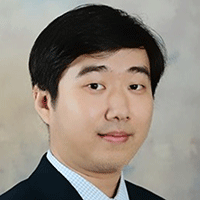Track Keynotes are speakers that will be highlighted within a specific track. The speaker will present for 40 minutes.
July 22, 2024, 10:20am - 11:00am
Guided Waves Track
Session: 05-01: Guided Waves I

PRESENTING AUTHOR
Cliff Lissenden, Ph.D.
Professor of Engineering Science and Mechanics
The Pennsylvania State University
Title: Lamb Wave Mixing for Early Detection of Damage (Paper Number: 145488)
Abstract: Nonlinear ultrasonics enables detection of damage precursors because it is sensitive to material microstructure evolution. The material nonlinearity causes distortion of the waveform that is evident in the frequency spectrum. However, the distortion is small and often a challenge to detect. Therefore, researchers have sought ways to obtain a highly sensitive, reliable, and repeatable measurement. Mixing Lamb waves enables scanning reasonably large regions of interest in a plate. Using the fundamental Lamb wave modes at frequencies below the lowest cutoff is often preferred in NDE so that a single mode can be actuated. We propose to mix counter-propagating S0 and A0 Lamb waves in an aluminum plate. Frequency selection to obtain internally resonant secondary A0 waves at the difference frequency that propagate in the direction of the S0 waves is described. Transducer selection to predominantly generate S0 and A0 primary waves for structural health monitoring is also described. Nonlinear finite element analysis demonstrates the effect of the primary wave amplitudes on the secondary waves. Linear finite element analysis demonstrates the effect on the wavefield of fillets that reduce the plate width for fatigue testing. A laser Doppler vibrometer is used in the laboratory experiments to facilitate scanning the plate surface between the transducers. After all of the above considerations, signal processing is still critical, albeit straightforward. Results of ongoing experiments will be discussed.
Biography: Cliff Lissenden is a professor of engineering science and mechanics at The Penn State. He was the founding director of the Ben Franklin Center of Excellence in Structural Health Monitoring and is an ASME Fellow.
July 23, 2024, 10:20am - 11:00am
NDE for Civil Infrastructure Track
Session: 08-01: NDE for Civil Infrastructure I

PRESENTING AUTHOR
Zheng Fan, Ph.D.
Associate Professor
School of Mechanical and Aerospace Engineering
Nanyang Technological University, Singapore
Paper Title: Detection of Early-Stage Corrosion in Reinforced Concrete Using Ultrasonic and Electromagnetic Methods (Paper Number: 147595)
Abstract: Corrosion of reinforcing bars is a critical factor in the degradation of reinforced concrete (RC) structures, leading to serious structural integrity issues. The expansion of corrosion products induces tensile stresses, causing the concrete cover to crack and spall, while the diminishing cross-sectional area of the reinforcing bars severely compromises the structure's load-bearing capabilities and bond strength. Hence, it is necessary to develop robust non-destructive evaluation methods to assess the corrosion damage at an early stage.
In this work, we propose the integration of both ultrasonic and electromagnetic approaches to identify initial signs of corrosion damage. Ultrasonic methods, renowned for their sensitivity to discrepancies in acoustic impedance, such as cracks and voids, are employed alongside electromagnetic techniques, which excel in detecting metallic structures due to marked differences in dielectric permittivity and conductivity. Specifically, the application of ultrasonic coda wave interferometry and Rayleigh wave spectroscopy offers the opportunity to track the progression of internal cracks within reinforcing bars. Concurrently, a linear multiple-input-multiple-output (MIMO) Ground Penetrating Radar (GPR) array is utilized to visualize the reinforcing bars within concrete. This method excels in the early stages of corrosion, where rust formation and the inception of small cracks result in noticeable alterations in the GPR images. Additionally, a wide-band dual-polarized GPR system is also investigated to capture the signal changes due to early corrosion damage. The efficacy of the proposed ultrasonic and electromagnetic methods has been validated through experimental work with accelerated corrosion in the laboratory.
Biography: Dr. Zheng Fan is an associate professor in the School of Mechanical and Aerospace Engineering at Nanyang Technological University, Singapore. He earned his Ph.D. degree in Mechanical Engineering from Imperial College London in 2010, and his Bachelor's and Master's degrees in Acoustics from Nanjing University in 2004 and 2006, respectively. Currently, he leads a research team dedicated to developing novel techniques for the non-destructive evaluation, structural health monitoring, and sound manipulation. His work integrates advanced physics and modeling techniques with the development of technologies that can be rapidly deployed in practical settings. Dr. Fan maintains strong links with the global industry, collaborating with major companies such as Rolls-Royce, Shell, Lloyd's Register, EDF, and Sembcorp, etc. His research spans from thorough investigations of fundamental theories to the application of science in addressing real-world challenges. The results of his work have been published in over 80 papers in top tier journals, including Nature Communications, Physical Review Applied, Proceedings of the Royal Society A, Journal of Sound and Vibration, etc. He holds two international patents and has successfully licensed these technologies to industry partners. In 2018, Dr. Fan was awarded the Achenbach Medal for his outstanding contributions to structural health monitoring. In 2023, he was ranked among the world's top 2% of scientists by Stanford University. Dr. Fan also serves as an Associate Editor for "Structural Health Monitoring – An International Journal" and "Ultrasonics," two leading journals in his field.